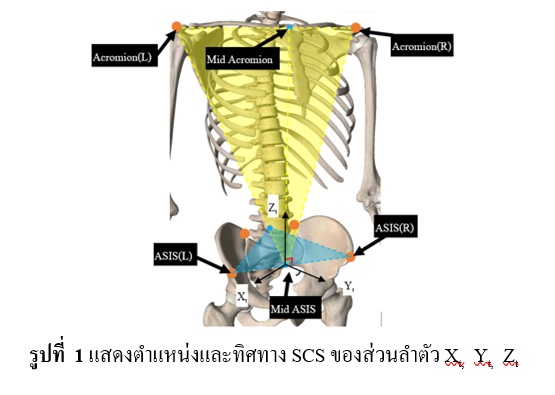A COMPARISON OF BIOMECHANICAL VARIABLES OF GOLF SWING AMONG DIFFERENT SLOPES IN AMATEUR GOLFERS
Main Article Content
Abstract
Purpose : The purpose of this study was to compare the biomechanical variables of golf swing during golf shots on flat, uphill, and downhill slopes.
Methods : Sixteen male amateur university golfers with right-handed volunteered to participate in the study. The participants performed 5 swings on three different slope conditions (flat, uphill and downhill). The customized swing plate was used to create uphill and downhill slopes of ±10° and was installed equipments for recording club head speed and ground reaction force. Kinematic data were collected using infra-red motion capture cameras. The biomechanical variables of highest club head speed for each participant under each condition was selected in order to specify variable’s values at each event (address, top-backswing, mid-down swing and ball-impact) for statistical analysis.
Results : The results revealed thai the stance width was significantly wider (p < .05) for the uphill and downhill slopes compared to the flat condition. Compared with a flat swing condition, uphill and downhill condition showed significantly higher and lower (p < .05) ground reaction force at lower foot and higher foot, respectively. For motion analysis, uphill condition showed significant differences in hip flexion and knee flexion in every swing event while there were no significant differences in knee flexion and hip flexion at some swing events for the downhill condition. Finally, performance outcomes evaluation showed significantly lower in club head speed and trunk rotation velocity between the flat and uphill conditions (p < .05). In contrast, there were no significant difference in trunk rotation velocity and club head speed between flat and downhill condition.
Conclusion : Golf swing under uphill and downhill should stance wider for balancing against weight that transfer to the lower foot. Furthermore, Golfer should keep swing motion similar to normal swing which normally perform in the flat condition as much as possible in order to maintain trunk rotation velocity which importance to develop club head velocity.
Article Details
References
Bartlett, H. L., Ting, L. H., & Bingham, J. T. (2014). Accuracy of force and center of pressure measures of the Wii Balance Board. Gait & posture, 39(1), 224–228.
Blenkinsop, G. M., Gallimore, N. J., and Hiley, M. J. (2017). Weight tranfer changes during golf shots from deffernt lies. Paper presented at the International Society of Biomechanics in Sports conference proceedings archive, 35(1), 77.
Bradshaw, E. J., Keogh, J. W. L., Hume, P. A., Maulder, P. S., Nortje, J., and Marnewick, M. (2009). The Effect of Biological Movement Variability on the Performance of the Golf Swing in High- and Low-Handicapped Players. Research Quarterly for Exercise and Sport, 80(2), 185-196.
Chu, Y. C., Sell, T. C., and Lephart, S. M. (2010). The relationship between biomechanical variables and driving performance during the golf swing. Journal of Sports Sciences, 28(11), 1251-1259.
Damavandi, M., Eslami, M., and Pearsall, D. J. (2017). Side-sloped surfaces substantially affect lower limb running kinematics. Sports Biomechanics, 16(1), 1-12.
Hellström, J. (2009). Competitive elite golf. Sports Medicine, 39(9), 723-741.
Hume, P. A., Keogh, J., and Reid, D. (2005). The role of biomechanics in maximising distance and accuracy of golf shots. Sports Medicine, 35(5), 429-449.
Langdown, B. L., Bridge, M., and Li, F. X. (2012). Movement variability in the golf swing. Sports Biomechanics, 11(2), 273-287.
Peters, R., Smith, N., and Lauder, M. (2016). Quantifying the gradients exposed to a professional golfer during a round of golf. Paper presented at the International Society of Biomechanics in Sports conference proceedings archive.
Pichardul, K., and Limroongreungrat, W. (2016). Kinematic of two golf swing conditions in competitively professional golfers. Journal of Sports Science and Technology, 16(1), 1-10.
Wang, J.-J., Yan, P.-F., and Shiang, T.-Y. (2007). A kinetic analysis on golf swings to know what skill can increase club head speed and impact accurasy. Journal of Biomechanics, 40, S765.


